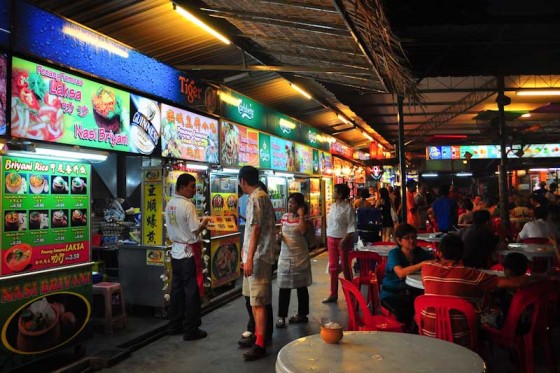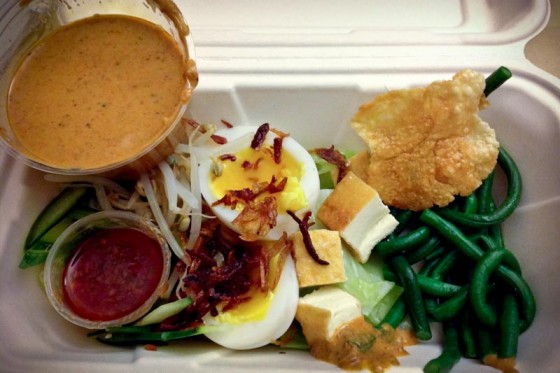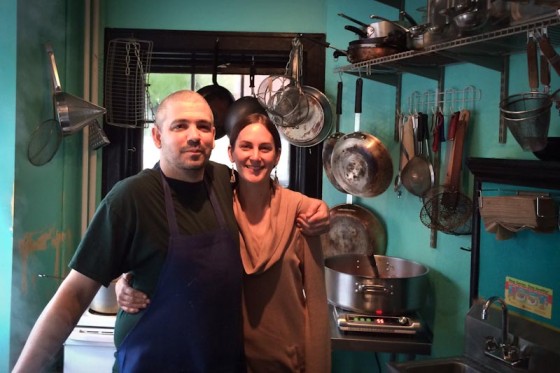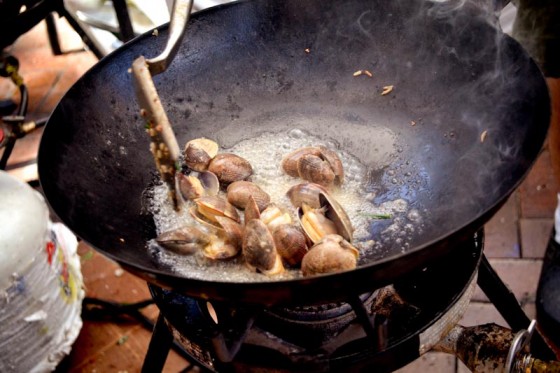Seattle tends to have its bases covered when it comes to Asian food. But the owners of Kedai Makan are working hard to introduce Malaysia’s eclectic cuisine to Northwest palates.
When Kevin Burzell and Alysson Wilson met as travelers in Germany, they didn’t think they would be starting a restaurant together. But a curiosity about the world and extensive travel through South East Asia inspired the partners to start serving Malaysian food in farmers markets around Seattle.
Spurred by overwhelming demand, last year the team opened Kedai Makan, one of just a few restaurants in the region devoted to Malaysian food.
“Kedai Makan” is Malay for “food shop.” Burzell helms the kitchen, and Wilson is likely to be the smiling face you see as you place your order.
I, for one, was overjoyed to hear of Kedai Makan when I moved to Seattle this summer. I’m Singaporean — and Malaysian food reminds me of home.
When I got here I was surprised to find a plethora of Thai, Vietnamese and Indian restaurants all over Seattle, but Kedai Makan was the only Malaysian restaurant I could find outside of the International District.
Kedai Makan is takeout only, but diners can eat at neighboring Montana Bar. While finances dictated the lean operation, the eatery also evokes the “hawker stall” concept that is prevalent in Malaysia and other parts of the region.
In Malaysia, families can get food to go from various stands and then sit in one communal area — or back at home — to eat. Similarly at Kedai Makan, Wilson says it’s not uncommon for one person to buy multiple dishes to take back for the whole family to eat.
 Food hawker stalls in Pulau Penang, Malaysia, where customers by food from individual stalls and then eat in a communal dining area, or at home. (Photo by Davidlohr Bueso)
Food hawker stalls in Pulau Penang, Malaysia, where customers by food from individual stalls and then eat in a communal dining area, or at home. (Photo by Davidlohr Bueso)
“We’re making it like a small takeout hawker stand as best we can,” says Burzell.
The duo are super busy between 4 PM and 11 PM when the restaurant is open (and until 2:30 AM on Friday and Saturday.) I scored some time with them before opening, as Burzell chopped, cooked and sharpened knives during our interview. The kitchen is not much larger than an average apartment kitchen, but magical things happen in small spaces, it seems.
I was surprised to learn that neither Burzell nor Wilson are Malaysian, or have spent much time there. In fact, Wilson says she was never even interested in traveling to Asia, preferring Europe as a traveler. But once the couple visited the tropical country, there was no turning back. After just a month’s stay in Malaysia, the partners were enchanted by the flavors and techniques of the cuisine.
“Of course, we have a passion for Malaysian food, plus there are already plenty of other Asian restaurants here, but not Malaysian,” says Burzell.
Seattleites, for their part, seem to be enjoying this previously untapped cuisine. Diners brave traffic, difficult parking and weather for their dose of Malaysian food. Interestingly, the partners face many questions like “what exactly is Malaysian food” and “what’s the best dish on the menu?”
So, what is this mysterious cuisine all about? Wilson calls it a “melting pot of flavors,” with influences from China and India.
“You have to like bolder, spicier, stronger flavors. It’s not a bland cuisine, flavors are strong and intense but if you like Thai, Vietnamese, Chinese or Indian, there’s a good chance you’ll like it,” Burzell jumps in.
 Duck egg gado. (Photo courtesy Kedai Makan)
Duck egg gado. (Photo courtesy Kedai Makan)
The menu is in English, but can be intimidating to the uninitiated. While there are a few constants on the menu (listed on a whiteboard outside where you order), the specials change daily.
So, what to order? Nasi goreng or pan mee? Do you like sambal belacan with that?
You’re wondering if autocorrect had a field day with my writing, right? Actually no, those are all Malay delicacies on the menu.
Nasi lemak ($12.50), Burzell’s favorite dish, is a staple you’re likely to get anywhere in Malaysia. The coconut and pandan leaf-infused rice is served with spicy turmeric chicken, crispy anchovies, peanuts, cucumber, fried egg and sambal belacan – a spicy shrimp paste that’s a mainstay ingredient in this cuisine.
“We do have to educate people that sambal is not like Sriracha and it’s not overly ‘shrimpy,’” laughs Wilson.
Indeed, part of their experience running the restaurant has been constantly informing customers how to eat the food.
For example, new to the menu is chili pan mee ($9.50) a spicy pork noodle served with a side of broth. The couple debated whether to serve it the authentic way, with a side of broth, or whether “it would just get lost,” says Wilson.
“We get people asking if they should pour the broth into the noodles and we need to explain: No, it’s to sip on the side to enhance the flavors,” says Burzell. “Part of what we’re trying to do is trying to inform people. Teach them.”
“Without being pretentious,” adds Wilson.
 Kevin Burzell and Alysson Wilson in Kedai Makan’s tiny kitchen. (Photo by Ruchika Tulshyan)
Kevin Burzell and Alysson Wilson in Kedai Makan’s tiny kitchen. (Photo by Ruchika Tulshyan)
The truth is, Kedai Makan doesn’t taste authentically Malaysian. Back home, flavors are stronger and oilier. But that’s not to say Kedai Makan doesn’t deliver a really excellent meal. In fact, exactly replicating the cuisine wasn’t on their agenda in the first place. Using Burzell’s culinary expertise and the duo’s travel experience, the restaurant presents its own interpretation of the cuisine.
Burzell emphasizes: “We don’t want our food to taste like somebody else’s dish from Malaysia. That’s what any good hawker does in that part of the world. They don’t copy someone else’s dish. They take it and make it their own.”
Personally, what I love about Kedai Makan is there’s something for everyone: you could eat roti canai (a crispy bread) or noodles or rice, depending on your mood. In some ways, Kedai Makan’s food mirrors the ‘melting pot’ of Seattle, particularly on Capitol Hill.
For now, Kedai Makan is about as close to Malaysian food as we’re going to get in the area. As winter approaches, I can’t think of a better way to warm up with the heat of sambal belacan and toasted peanuts.
Kedai Makan is located at 1510 East Olive Way in Seattle. Hours are Sunday to Thursday, 4 pm to 11 pm and Friday and Saturday 4 pm to 2 am.



Ahhhh…I’ve spent a fair amount of time bouncing back-and-forth between Malaysia and Indonesia. One of the joys of being in Kuala Lumpur was gorging at the amazing food at stalls like the one pictured in Penang and Jalan Alor. Awesome read! Now me and my stomach are Malaysia home sick!
Thanks for your thoughts, Branden! Hope this brings you to Seattle for some “makan” when you miss that region!
It’s definitely not Malaysian food. Just some hints of Malaysian flavours. Not really worth it if you are looking for the real stuff. There are other Malaysian restaurants, own and cook by Malaysians.
This is a cheap copy of what Malaysian food is. Please …. For goodness sake, correct your description of Malaysian food. It’s a blend of Arab, Chinese, Indian and English food.
I ordered a few typical Malaysian dishes and it was nothing close. I am from Penang (not Pulau Penang), Malaysia and this is a cheap knock off.